Anger Foot Review
Many gamers find great comfort when replaying their favorite shooters. Satisfaction comes from the familiar: redeploying a powerful weapon, reliving a momentous scripted sequence, revisiting an iconic location, or facing a memorable foe once again. Most developers of first-person shooters strive to evoke this same feeling. Some go further, focusing on replayability. Anger Foot is one such example, featuring a prominent kick melee attack and influenced by old-school titles. Like a first-person version of Hotline Miami, players are easily felled and destined to retry levels. While the combat is enjoyable in its raw, compressed form, the action can become a grind.
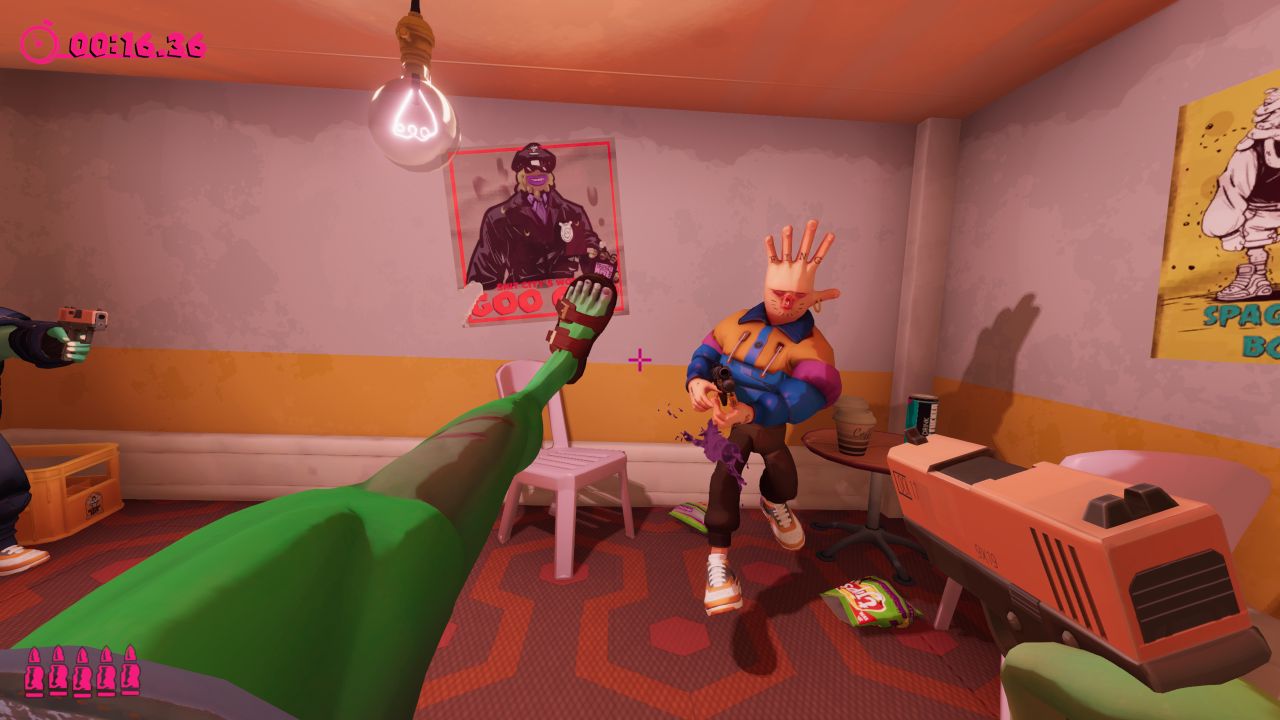
Some will get a real kick out of Anger Foot
Like older shooters, Anger Foot runs with minimal story. The player character, Anger Foot, begins the game having just collected the last of four Preemo shoes. Unfortunately his coveted footwear is immediately stolen. The player’s goal is to recover each one by defeating the four main gangs that reside in Sh*t City, run by the titular Crime Minister. This sole searching takes players through hostile apartment buildings, sewers, offices, and dungeons. And, occasionally, there is the opportunity to explore non-combat spaces, to listen from civilians about the city or gangs, although these try a bit hard to be funny and rarely add meaning to the world.
Besting each gang requires the completion of roughly fifteen short levels, taking 1-3 minutes and trending longer over the game’s six hour runtime. Each completion rewards players with a star, and additional stars are granted for completing mission-specific goals, like finishing the level in a set time limit or playing a certain way. These stars unlock shoes (on top of the four Preemos) that can be worn to alter combat. As enemies are numerous and the player is fragile, death comes quickly, after just 2-3 bullets or a single melee attack. Saving mid-level is not possible, so levels will be replayed several times, with a quick-restart option. While replaying maps is common, the game only gets difficult late. And in the trickier situations, the basic AI can be exploited by camping near doorways and waiting until they come close enough to kick.
The kick melee attack is a huge part of combat. It can be used frequently, has decent range, and instantly kills most opponents. The kicking foot comically propels outwards from arm height (legs are otherwise invisible) and the leg attack is also used to activate switches and levers. Kicking is also the only way to open the game’s many doors, and these break with a nice satisfying crunch, propelling the whole door forward to kill whoever is standing behind it. Some of the unlockable shoes alter the kick functionality directly, changing it to a charged kick, uppercut, or flurry, for example.
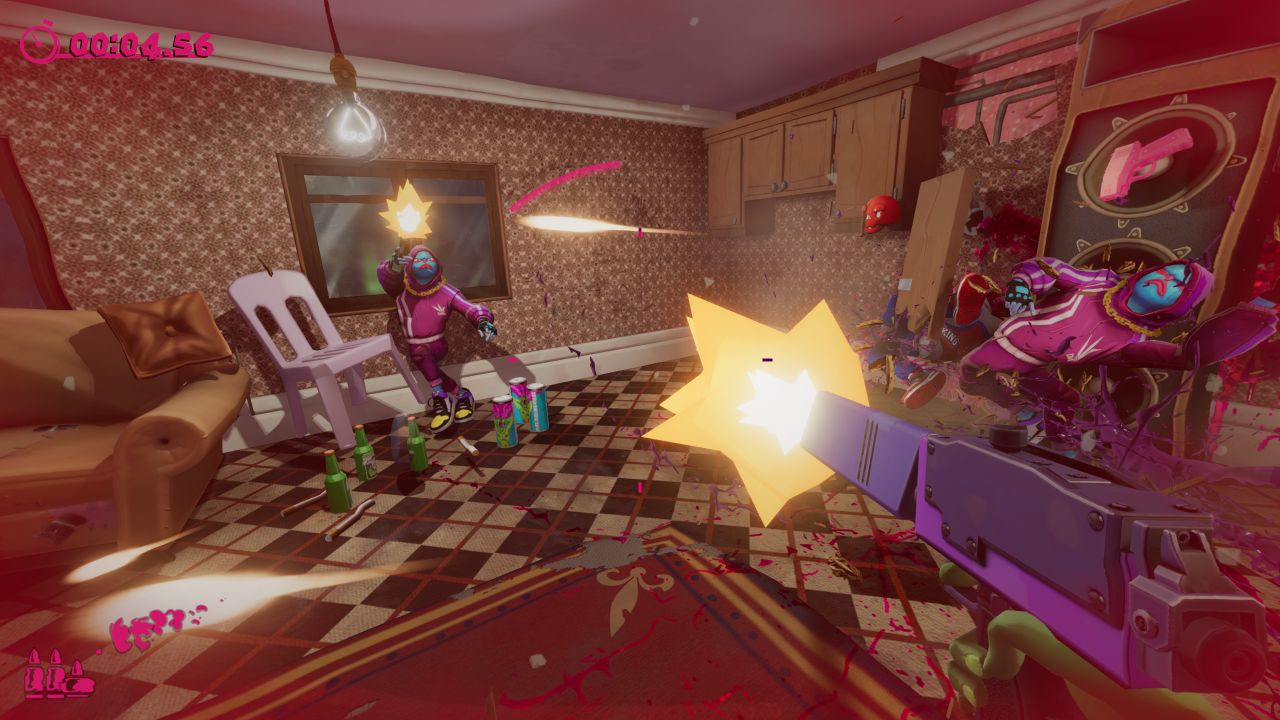
Want to lower the gravity? There’s a shoe for that
Unfortunately most of the 20+ shoes (including Preemos) are merely underwhelming modifiers. Some are gimmicks, like the clown shoes that spew confetti and spin ragdolls. Another lowers gravity, and although this helps to complete some levels fast, it is otherwise a liability. Only a few provided notable, consistent benefits, including one that granted an extra life and two that either slowed time or granted a speed boost, after kicking through a door. Unless you are seeking to complete a level in a particular way, it is likely that you will stick to one or two pairs. Perhaps the game would have benefitted from a shoe upgrade system, to foster diversity and add more progression.
Combat is not all about kicking though, since players can equip a broad and predictable arsenal. Weapons include a pistol, sub-machine gun, shotgun, crossbow, assault rifle, flamethrower, and grenade launcher. Unlike most shooters, weapons have extremely limited ammo and must be thrown away when empty. Thrown weapons do stun enemies, which allows for a nice follow-up kick. Keeping track of weapon drops (associated with enemy types) helps to make the combat engaging. This is offset by their tendency to get lost amidst broken furniture and the annoyance of accidentally picking up a weapon that you previously tossed because it was empty.
Combat is quite enjoyable during the first run of a level. After kicking a door, a rapid assessment is required. Which enemies pose the greatest threat? Which are best felled with a kick to preserve ammo? Which spaces offer cover or danger? Pushing into the chaos, smashing door after door, kicking or shooting foes, grabbing new weapons, and completing everything with speed is when the action hits its apex. It is disappointing that the game does not feature some type of combo bonus, like in Call of Juarez: Gunslinger or Bulletstorm, to further encourage aggressive play. And when difficulty spikes, it is safer to hold back and peak out, simply because health regenerates and enemies are less effective at range. So the game does not always guide players towards its most enjoyable style.
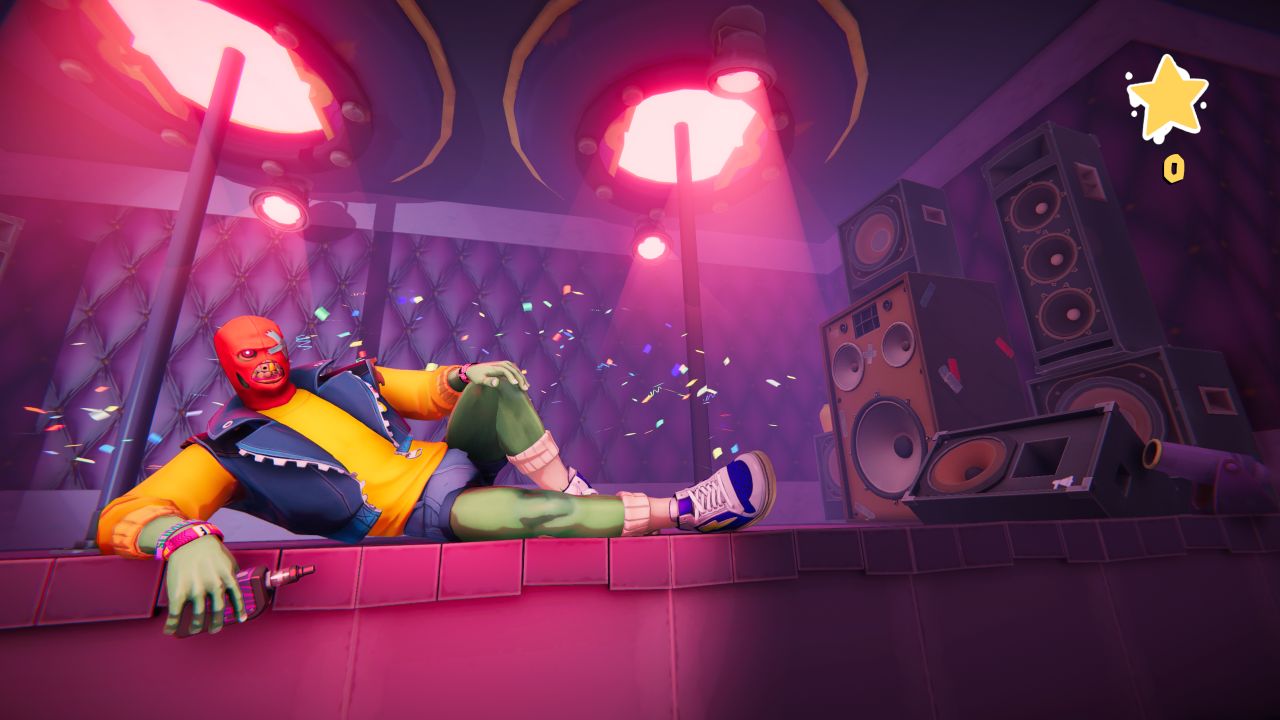
The best way to play is definitely not lying down
The levels are unfortunately mazes and rarely memorable. Most are cramped interior spaces with limited exterior views. Although the maps are not randomized, their design feels like they were created by an algorithm, with rooms glued together in odd ways. There are alternate routes and funny secret areas, though these can add more navigational confusion. The final gang’s hideout is set in an underground dungeon / strip club, which mixes the darkness of something like Hexen with the depravity of Duke Nukem 3D, but the end result is unappealing. At least most levels have a good amount of clutter that gets jostled or broken during combat, to bring life to battles.
Enemy designs are based on animals, either direct copies or anthropomorphic versions, including mice, crows, pigeons, dogs, alligators, and snakes. Although you face off against four different gangs, the core fodder types are reused. Enemies tend to showcase the game’s old-school influences. One nimble foe is reminiscent of the female assassins from Half-life 1, and another will instantly draw comparison to Doom’s Cacodemons. While the game does steadily introduce a few enemy types (and weapons), it is still quite homogenized across the campaign.
Anger Foot’s difficulty may cause some annoyance, but it can be tweaked. The easiest setting reduces incoming damage quite a bit, although players are still relatively frail against large groups. The never-die option, however, makes the game never fun. There is some inherent randomness to action, with enemies landing shots at near impossible angles, so deaths can seem unfair. End-level difficulty spikes persisted and lame gotcha moments grew tiresome, with both leading to replaying minutes of ‘easy’ combat just to retry that one spot. Players who are well-versed with shooters will not have trouble on the default setting, aside from a few spots near the end. And those less skilled can memorize enemy locations, since this does not change from one playthrough to the next.
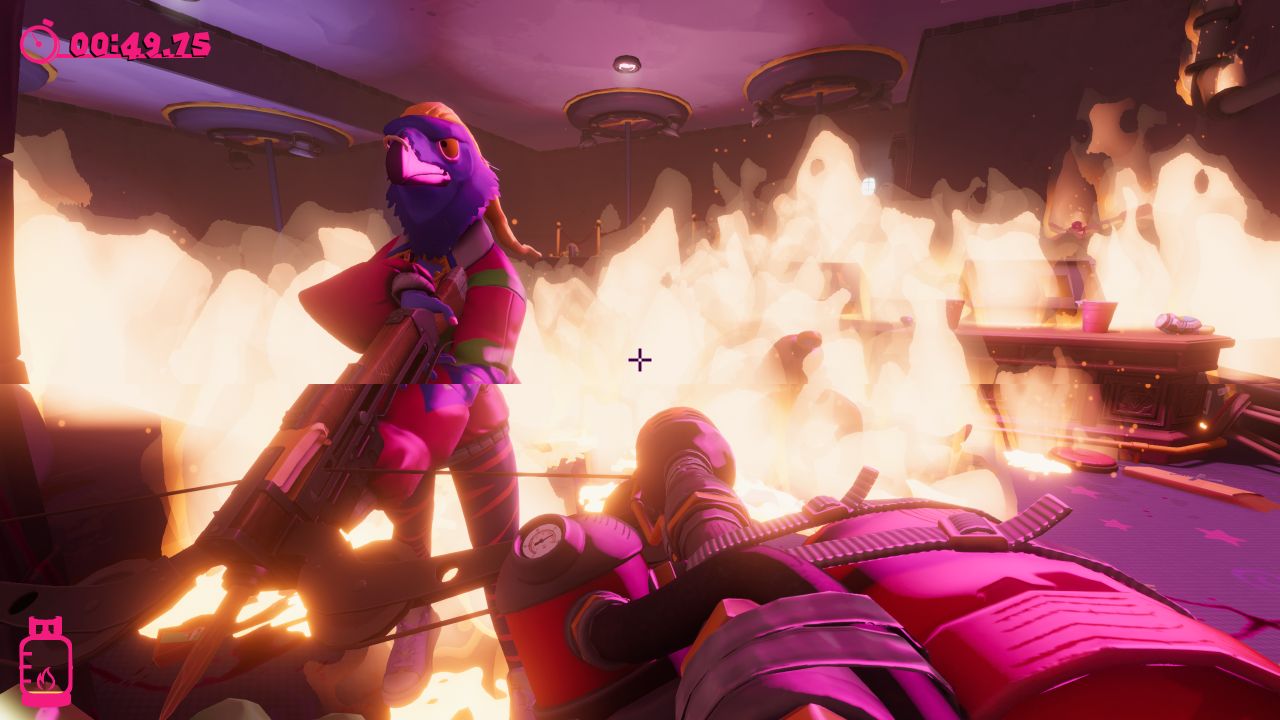
Difficulty spikes will make you feel the heat
But while not a difficult game, it can still be a chore to play. Part of this is just because it is still quite repetitive, even when excluding the intended replaying of levels. The maze-like level structure contributes heavily to the sameness, but also the reused enemy types and the basic gameplay loop of kicking doors and taking names. It does try to change things late in the campaign with a few vehicle sections, and the handful of gang bosses do have unique encounters, but this does not amount to enough variety. So while the individual pieces of combat are fine, playing large chunks can be a drag, analogous to the Library levels in the first Halo.
Also a little repetitive is the thumping electronic dance music, which is good in smaller doses. The base-heavy backbone pounds away and only fades when out of action. Although the music changes on a per level basis, it is not different enough until you are fighting a new gang, and even then it seems too familiar. The same beat persists and the loops are short, so the tunes become a grind after a few hours, like the action. Music is partially integrated into the game world too; lights and objects oscillate to the beat, becoming like a rudimentary version of Hi-Fi RUSH. And after the player dies, enemies pay their respects by dancing around your bullet-riddled corpse.
Visually the game is a vibrant neon playground with great contrast. The various enemy types pop out well against the muted background. Purple glowing blood and ragdoll corpses litter the hallways after a battle, even if this sometimes tanks the framerate. Levels load quickly and not many bugs were observed, outside of funny things like the kick still working after death and ragdolls going haywire.
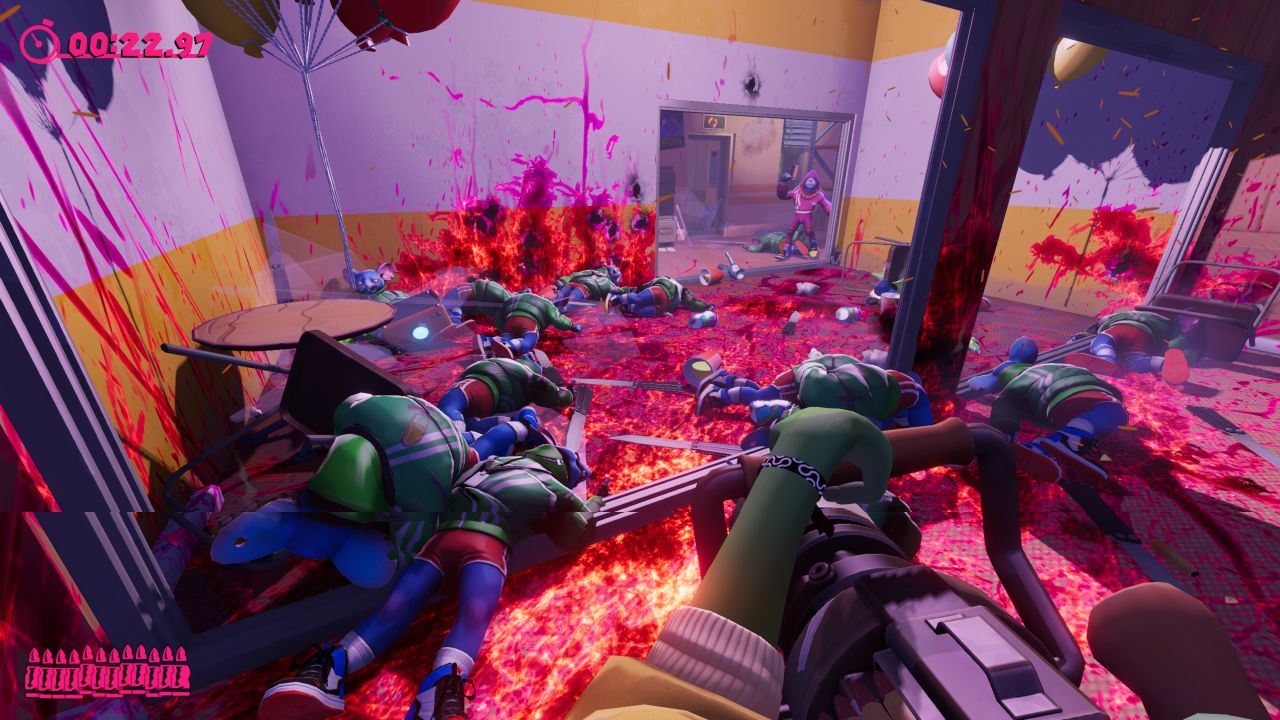
The colorful aftermath of battles is quite nice
Anger Foot is a competent arcade FPS that will be the ideal jam session for some gamers. Its core kick mechanic is satisfying, even though not many of the shoe unlocks are great. The level design is a bit of a letdown, due to the maze structures and forgettable designs. Difficulty spikes intend for players to replay levels, a bit like Hotline Miami, although it is not a hard game overall. Visually it is colorful and interesting, with contrast that works well for the rapid action. The bass-heavy dance music is fine for a while, but even it starts to grate. And so the game becomes tiresome to play over longer sessions, although it offers enough to hold interest over its six-hour campaign. While some may think Anger Foot is a snug arcade shooter, this is not a case of one size fits all.
